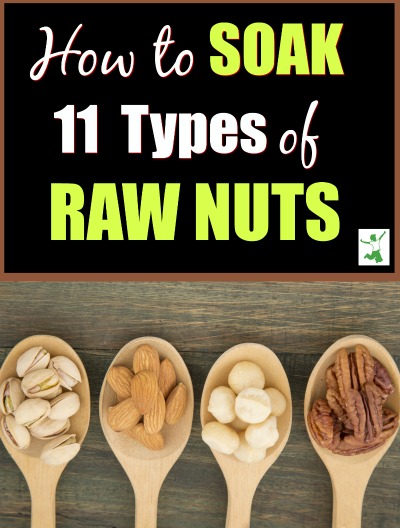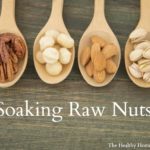
Raw nuts are one food that everyone seems to agree are very healthy to eat!
Whether you are vegan, vegetarian, Paleo or someone who eats the standard American diet of burgers and fries, raw nuts are one food that all acknowledge is a good addition to the diet. Here’s where the agreement about raw nuts ends.
The problem is that most people don’t know that soaking raw nuts first before eating them is very important. Soaked raw nuts are far more digestible than plain raw nuts. The soaking process eliminates anti-nutrients and improves nutrition while still maintaining rawness. Note that soaking does not eliminate the high amount of oxalates in nuts, however.
Raw Nuts are Seeds
While raw nuts are an extremely nutritious food, preparation is key in order to unlock maximum nutrient potential. Careful soaking deactivates any substances that could be irritating to the gut. The soaking process followed is in accordance with the wisdom of Traditional Cultures.
This is because raw nuts are a type of seed. Seeds require soaking before eating. The reason is because they contain anti-nutrients such as phytic acid and lectins that can prevent all that wonderful nutrition from being digested thoroughly.
These inhibitors can also cause digestive distress if many raw nuts are consumed. For some people, even a few raw nuts cause digestive distress. Sometimes, eating plain raw nuts can cause a rash around the mouth.
Benefits of Soaking Nuts
Deactivation of the anti-nutrients in all nuts is accomplished through sprouting or soaking. Soaking raw nuts in saltwater for a few hours and then drying in a warm (not hot) oven or dehydrator is all that is required.
According to Nourishing Traditions Cookbook, soaking and drying of raw nuts mimic the wise practice of the Aztecs. This culture soaked pumpkin seeds in brine and then dried them in the sun before grinding into flour or eating them whole.
Soaking nuts is a particularly helpful practice if you find raw nuts irritating to your stomach or mouth. My husband can eat soaked raw nuts with no problem. If he eats unsoaked raw nuts, however, he frequently experiences digestive issues and sometimes irritation around the mouth.
The anti-nutrients in raw nuts really bother some people. Even if you have no symptoms, you are likely not absorbing their wonderful nutrition as well as you could.
How Many per Day to Eat?
While extremely nutritious, it is best to keep the amount of soaked raw nuts consumed each day to a closed handful at most. This is in keeping with the recommendation of Dr. Kellyann Petrucci ND, author of the Bone Broth Diet. The reason is that most nuts contain an abundance of polyunsaturated fats, which are easily overconsumed. Too many polyunsaturates in the diet can contribute to inflammation and weight issues.
The one exception to this is macadamias. These nuts that are native to Australia contain mostly saturated and monounsaturated fats and an extremely small amount of polyunsaturated fats per serving.
By the way, if you’ve ever wondered how nuts rank nutritionally, the linked article provides the breakdown of the healthiest to unhealthiest types of nuts.
Where to Buy Quality Soaked Raw Nuts and Nut Butters
Don’t have time to soak and dry raw nuts yourself?
Yes, it is a bit time-consuming!
Check out my shopping guide for quality suppliers of soaked nuts and nut butter. We use 4-5 jars of soaked nut butter in our home every single month. Our family favorites are soaked pecan butter, soaked macadamia nut butter, soaked hazelnut butter, soaked almond butter, and soaked 4 nut blend.
How to Soak Raw Nuts
If you like to eat raw nuts whole, soaking them yourself first is very easy! Below is a recipe on how to soak the 10 most popular raw nuts followed by a video demonstrating the basic process.
Note that the process described below does not apply to a foraged superfood such as acorns. This type of nut requires an extended soaking of up to a week as practiced by Native Americans to properly remove the bitter tannins before drying and eating.
In the video below, I demonstrate how to soak raw almonds and dry them in your oven to greatly improve nutrient absorption, reduce gastric distress. You will be amazed at how soaked raw nuts taste far better than unsoaked raw nuts!
The same process can be followed for macadamia nuts, pecans, brazil nuts, peanuts, etc. The video on soaking raw nuts included with the recipe below shows how easy the process is!
Soaking Cashews
Note that soaking cashews is a bit different. This is because raw cashews from the store are not really raw.
They are heat-treated twice by manufacturers to release and remove a toxic oil between the inner and outer shell.
What to Do with Soaked Almonds?
When you make your first batch of soaked almonds, try this easy recipe for blueberry almond milk!
Blend 1 cup soaked almonds, 3 cups filtered water, 1 tsp vanilla extract, and 1/4 cup blueberries. Serve and enjoy!


Soaked Raw Nuts Recipe
The process of soaking raw nuts to improve digestibility and eliminate anti-nutrients.
Ingredients
- 4 cups raw nuts preferably organic
- 1 Tbl sea salt
- filtered water
Instructions
-
Place raw nuts in a large glass bowl (I use this one).
-
Add enough filtered water to cover.
-
Stir in sea salt.
-
Leave uncovered on the counter for 8 hours or overnight for almonds, European almonds, pecans, hazelnuts, pili nuts and macadamias.
Soak no more than 3 hours for cashews, and no more than 4-6 for walnuts, peanuts, pistachios and brazil nuts (else they will get moldy and/or slimy).
Do not mix raw nuts while soaking. You may mix while dehydrating.
-
Drain water completely.
-
Dry in a warm oven no hotter than 150 F/ 66 C until dry. If your oven can't be set that low, use a food dehydrator (I like this one). Dry soaked cashews in a 250 F oven.
-
Store crispy nuts in airtight containers in the refrigerator or cool, dark pantry.
Recipe Video
Recipe Notes
Do not mix different types of raw nuts together when soaking. Soak almonds separate from cashews, for example. This minimizes chances for mold developing. Also, the soaking times for various nuts are different.
Instead of soaking peanuts, this traditional boiled peanuts recipe is an option too.








Once they have soaked it is very easy to remove the skins. Just place an almond between thumb and first finder and press and rub. They come off very easy. Sometimes they will even shoot a distance so watch your aim. If I am doing a large batch they will sometimes start to dry before I finish them so I just pour more spring water over them in the colander and they will peel very easy. If they are ground with skin on it is called almond meal, if they are ground with skin removed it is almond flour and much easier to bake with.
Sarah, I need some troubleshooting tips! I soaked macadamias overnight and dehydrated them at 105 – I saw that as the temp somewhere on the internet – for 24+ hours, maybe 27. They came out not crispy. I think next time I’ll up the temp – all the way to 150? Thanks for any thoughts!
Laura
Yes 150F is a good temperature. They will come out buttery and crisp. You will love them!
Didn’t know about the different soaking times depending on the type of nut. That’s why my cashews were always slimy!
hi,
so basically once I soak them then I can keep in fridge for a while instead of making small batches every day? can you give soaking times for seeds like pumpkin and sunflower please? is it necessary to dehydrate or I can soak a small batch and use right away to toss in salad?
thanks
Rachel
I bought some raw cashews, walnuts, and peanuts. I soaked them together for about 7 hours. I then put them in my dehydrator for 24 hours. After soaking, the cashews turned a purplish color. Why would that happen>
It is best not to mix nuts and soak them together because different nuts have different recommending soaking times.
I want to know about chestnuts too.
I can’t find anything here or online about chestnuts. To soak chestnuts in brine or not to soak them in brine? Given I’m happy with the concept of soaking a nut (which is essentially a seed) – (that I’m NOT going to sprout) – in brine (1.5% ie 1.5grams:100ml) in order to deactivate the enzyme inhibitors (phytogens? is that also the right word?) I’m actually going to brine them for 24 hours, then cut the “X” in, and roast them – and if they taste good: then that’s how I’ll deal with them from here on in.
Great site, great information. Thanks.
Now I’m off to read and get to grips with the “brine your pasteured turkey” article – thanks so much for all the great information.
Hello Sarah,
Thank you for your helpful how-to-videos. I purchased soaked & sprouted nuts and couldn’t believe how much better I digested them. I am excited to make my own soaked & dehydrated nuts. My oven only goes down to 170 degrees. It is digital but I have not been able to figure out how to set it to a lower temperature using the oven manual. It does not appear to be possible. Can you provide any additional tips or suggestions? Also, can I dehydrated nuts at the 170 degree temperature?
170F is unfortunately too hot for dehydrating. I would suggest a counter top dehydrator. They are actually quite affordable. This stainless steel one is on my wish list! https://amzn.to/2bwJVwQ
Hi Sarah,
Really useful article and Video! I LOVE soaked and dehydrated nuts. I have A question about the temperature of drying the nuts. Once the nuts are dehydrated, how long will they last in the pantry or the fridge?
In the pantry, they will go stale within a couple of weeks. But, in the fridge a couple of months easily!
Is it necessary to dehydrate the peanuts after soaking them if you are planning on making peanut butter? It would seem like it would make easy peanut butter if they were damp, but it probably would mold quickly in the fridge?
Probably not necessary to dehydrate but it might make the peanut butter moist and subject to mold perhaps … good question!